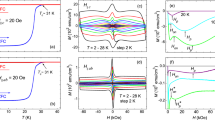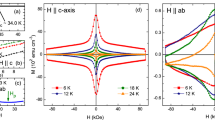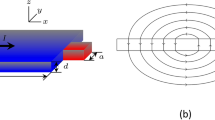Abstract
Iron pnictides are layered high Tc superconductors with moderate material anisotropy and thus Abrikosov vortices are expected in the mixed state. Yet, we have discovered a distinct change in the nature of the vortices from Abrikosov-like to Josephson-like in the pnictide superconductor SmFeAs(O,F) with Tc~48–50 K on cooling below a temperature T*~41–42 K, despite its moderate electronic anisotropy γ~4–6. This transition is hallmarked by a sharp drop in the critical current and accordingly a jump in the flux-flow voltage in a magnetic field precisely aligned along the FeAs layers, indicative of highly mobile vortices. T* coincides well with the temperature where the coherence length ξc perpendicular to the layers matches half of the FeAs-layer spacing. For fields slightly out-of-plane (> 0.1°– 0.15°) the vortices are completely immobilized as well-pinned Abrikosov segments are introduced when the vortex crosses the FeAs layers. We interpret these findings as a transition from well-pinned, slow moving Abrikosov vortices at high temperatures to weakly pinned, fast flowing Josephson vortices at low temperatures. This vortex dynamics could become technologically relevant as superconducting applications will always operate deep in the Josephson regime.
This is a preview of subscription content, access via your institution
Access options
Subscribe to this journal
Receive 12 print issues and online access
$259.00 per year
only $21.58 per issue
Buy this article
- Purchase on Springer Link
- Instant access to full article PDF
Prices may be subject to local taxes which are calculated during checkout




Similar content being viewed by others
References
Yin, Y. et al. Scanning tunneling spectroscopy and vortex imaging in the iron pnictide superconductor BaFe1.8Co0.2As2 . Phys. Rev. Lett. 102, 097002 (2009).
Vinnikov, L. et al. Vortex structure in superconducting iron pnictide single crystals. JETP Lett. 90, 299–302 (2009).
Das, P. et al. Small-angle neutron scattering study of vortices in superconducting Ba(Fe0.93Co0.07)2As2 . Supercond. Sci. Technol. 23, 054007 (2010).
Moll, P. J. W. et al. High magnetic-field scales and critical currents in SmFeAs(O, F) crystals. Nature Mater. 9, 628–633 (2010).
Karpinski, J. et al. Single crystals of LnFeAsO1−xFx (Ln = La, Pr, Nd, Sm, Gd) and Ba1−xRbxFe2As2: Growth, structure and superconducting properties. Physica C 469, 370–380 (2009).
Yamamoto, A. et al. Evidence for two distinct scales of current flow in polycrystalline Sm and Nd iron oxypnictides. Supercond. Sci. Technol. 21, 095008 (2008).
Gurevich, A. To use or not to use cool superconductors? Nature Mater. 10, 255–259 (2011).
Jaroszynski, J. et al. Comparative high-field magnetotransport of the oxypnictide superconductors RFeAsO1−xFx (R = La, Nd) and SmFeAsO1−δ . Phys. Rev. B 78, 064511 (2008).
Blatter, G. et al. From isotropic to anisotropic superconductors: A scaling approach. Phys. Rev. Lett. 68, 875–878 (1992).
Blatter, G. et al. Vortices in high temperature superconductors. Rev. Mod. Phys. 66, 1125–1388 (1994).
Kleiner, R. et al. Intrinsic Josephson effects in Bi2Sr2CaCu2O8 single crystals. Phys. Rev. Lett. 68, 2394–2397 (1992).
Tachiki, M. & Takahashi, S. Strong vortex pinning intrinsic in high- Tc oxide superconductors. Solid State Commun. 70, 291–295 (1989).
Van der Beek, C. J. et al. Flux pinning in PrFeAsO0.9 and NdFeAsO0.9F0.1 superconducting crystals. Phys. Rev. B 81, 174517 (2010).
Yamamoto, A. et al. Small anisotropy, weak thermal fluctuations, and high field superconductivity in Co-doped iron pnictide Ba(Fe1−xCox)2As2 . Appl. Phys. Lett. 94, 062511 (2009).
Zhigadlo, N. D. et al. Single crystals of superconducting SmFeAsO1−xFy grown at high pressure. J. Phys. Condens Matter 20, 342202 (2008).
Zech, D. et al. Angle-dependent reversible and irreversible magnetic torque in single-crystalline Y2Ba4Cu8O16 . Phys. Rev. B 54, 12535–12542 (1996).
Kidszun, M. et al. Critical current scaling and anisotropy in oxypnictide superconductors. Phys. Rev. Lett. 106, 137001 (2011).
Kwok, W. K. et al. Direct observation of intrinsic pinning by layered structure in single-crystal YBa2Cu307−δ . Phys. Rev. Lett. 67, 390–393 (1991).
Hatano, T. et al. Lock-in phenomena of Josephson vortices under vicinal layer parallel magnetic field. Jpn. J. Appl. Phys. 44, L27–L30 (2005).
Hechtfischer, G. et al. Collective motion of Josephson vortices in intrinsic Josephson junctions in Bi2Sr2CaCu2O8+y . Phys. Rev. B 55, 14638 (1997).
Welp, U. et al. Anisotropic phase diagram and superconducting fluctuations of single-crystalline SmFeAsO0.85F0.15 . Phys. Rev. B 83, 100513 (2011).
Nojima, T. et al. Superconducting anisotropy in single-crystalline Ba(Fe0.93Co0.07)2As2 near Tc . Physica C 470, S813–S814 (2010).
Koshelev, A. E. et al. Fluctuating pancake vortices revealed by dissipation of the Josephson vortex lattice. Phys. Rev. B 83, 224515 (2011).
Acknowledgements
L.B. is supported by DOE-BES through award DE-SC0002613. The NHMFL is supported by NSF through NSF-DMR-0084173 and the State of Florida. This work was supported by the Swiss National Science Foundation and the National Center of Competence in Research MaNEP (Materials with Novel Electronic Properties). We thank the Electron Microscopy Center ETH Zurich (EMEZ), in particular P. Gasser, for support of the FIB work, and K. A. Moler and A. Koshelev for discussions.
Author information
Authors and Affiliations
Contributions
B.B. and P.J.W.M. designed the experiment and wrote the paper with G.B. and V.G. The FIB work and the low-field experiments were performed by P.J.W.M. L.B. and P.J.W.M. performed the experiments in high magnetic fields in Tallahassee. V.G. and G.B. contributed to the theoretical discussion, and added Supplementary Information SC. The crystals were grown by N.D.Z. and J.K.
Corresponding author
Ethics declarations
Competing interests
The authors declare no competing financial interests.
Supplementary information
Supplementary Information
Supplementary Information (PDF 651 kb)
Rights and permissions
About this article
Cite this article
Moll, P., Balicas, L., Geshkenbein, V. et al. Transition from slow Abrikosov to fast moving Josephson vortices in iron pnictide superconductors. Nature Mater 12, 134–138 (2013). https://doi.org/10.1038/nmat3489
Received:
Accepted:
Published:
Issue Date:
DOI: https://doi.org/10.1038/nmat3489
This article is cited by
-
Second magnetization peak, anomalous field penetration, and Josephson vortices in KCa\(_2\)Fe\(_4\)As\(_4\)F\(_2\) bilayer pnictide superconductor
Scientific Reports (2022)
-
Effect of heat treatments on superconducting properties and connectivity in K-doped BaFe2As2
Scientific Reports (2021)
-
Angular dependence of vortex instability in a layered superconductor: the case study of Fe(Se,Te) material
Scientific Reports (2018)
-
Microwave emission from superconducting vortices in Mo/Si superlattices
Nature Communications (2018)
-
Exploring Multi-Component Superconducting Compounds by a High-Pressure Method and Ceramic Combinatorial Chemistry
Journal of Superconductivity and Novel Magnetism (2017)



